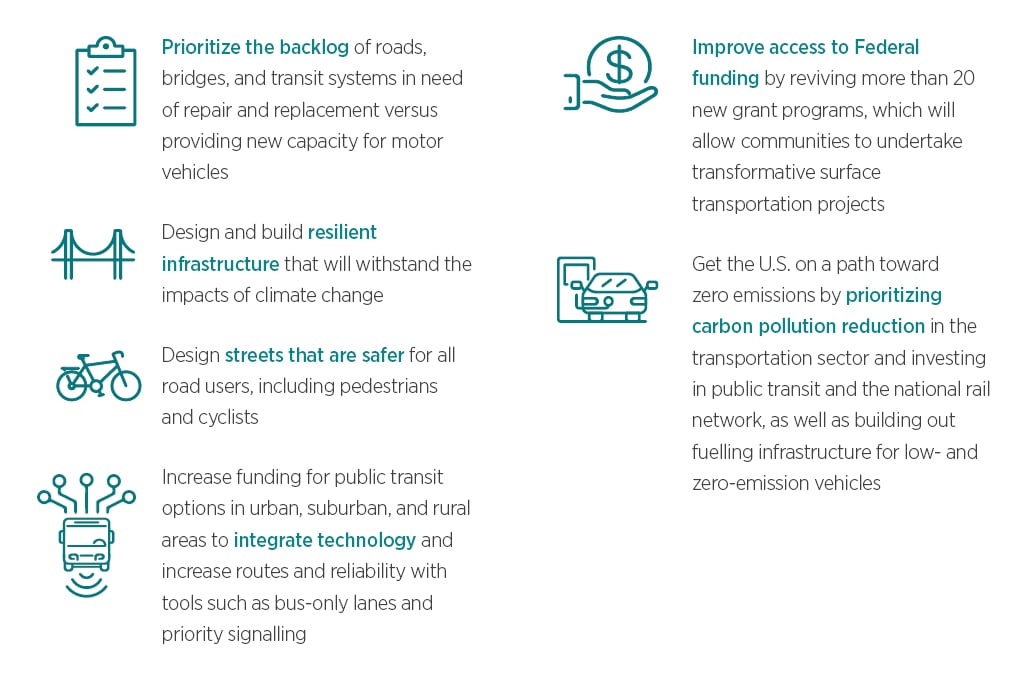State of the Market
In the wake of COVID-19, transportation agencies are struggling with significant revenue reductions which have created budgetary shortfalls and operational challenges. State Departments of Transportation (DOTs), transit agencies, and airports have lost billions of dollars in transportation revenues from decreases in motor vehicle usage, as well as a decline in train, bus, and airline travel. Budgets are being impacted by reductions in revenues attributed to passenger fares, toll revenue, diesel and gasoline tax collections, licensing and registration fees, rented and leased vehicles fees, as well as passenger air travel. In addition, consumers have pulled back on spending and this has affected transportation allotted revenues from their share of state and local sales taxes.
The decline in operating revenue has forced transportation agencies to pivot and make significant adjustments to their capital programs and expenditures. In the short-term, priorities were placed on maintaining safe and efficient operations and transportation systems which were essential to moving goods to market and transporting America’s workforce to their jobs. Budgetary shortfalls caused state DOTs to make cuts to capital construction projects such as new capacity and maintenance projects, including highway beautification, resurfacing, and major road and bridge repairs. Transit authorities are slashing subway and bus routes and service in major metropolitan areas and pushing off upgrades to critical systems. Airlines have decreased the number of flights and made significant reductions in their workforce. Contrasting the cuts in most of the country, some fortunate agencies with stable cash or alternate bonding methods have benefited from the lack of asset usage and have increased and accelerated construction efforts while maximizing schedules and cost efficiencies. However, the silver lining experienced by a few agencies does not outweigh the dire need of revenue being felt by most.
Surface Transportation Legislation
The surface transportation authorization bill Fixing America’s Transportation (FAST) Act expired on September 30, but Congress approved the Continuing Appropriations Act, 2021 and Other Extensions Act, which will enable transportation agencies to continue to receive funding for critical transportation infrastructure improvements. The continuing resolution prevented a federal government shut-down and continued appropriations through December 11, 2020. In addition, the bill includes a one-year extension of the FAST Act and surface transportation programs, which will provide DOTs and public transit agencies with a roadmap for FY (fiscal year) 2021 and the certainty they needed to plan for critical road, highway, bridge, and rail projects moving forward. A key element of the Act is the infusion of $13.6 billion into the Highway Trust Fund. The one-year extension will give lawmakers and Congress time to focus on the new multi-year transportation Act—The Moving Forward Act—that will guide development of our transportation systems over the course of the next decade. The INVEST in America Act, proposed earlier this year, was merged into this $1.5 trillion bill that serves as a gigantic investment in the nation’s roads, bridges, transit, rail, schools, housing, drinking and wastewater systems, clean energy sector, and health care infrastructure.
In its current state, the new legislation will replace the current surface transportation bill which authorizes spending on highways, transit, and other transportation programs. It was designed to place greater importance on maintaining deteriorated roads and bridges, improving bottlenecks along freight corridors, and enhancing aging transit and rail networks. The Act also focuses on reducing transportation-related pollution, which is currently the nation’s top source of greenhouse gas emissions causing climate change. The passage of the Moving Forward Act by Congress would make certain that transportation agencies will be able to advance their long-term infrastructure development goals.

The new surface transportation authorization bill would allocate funds to:

Navigating Change and Evolving Regulations
Right now, transportation agencies are faced with many unknowns. In the face of declining ridership and revenues, we stand behind the American Society of Civil Engineers (ASCE), who are urging policymakers to prioritize our nation’s infrastructure and get people back to work. The economic slowdown presents a great opportunity to make strategic investments that will strengthen outdated networks and advance our economy. The current surface transportation bill, FAST Act, is not adequate to support and address the issues that many of our clients are facing. Absent from the extension is acknowledgement of the need for increased funding to the aviation industry as a critical cog in our national transportation system. New legislation must provide additional funding for critical aviation infrastructure which will be left in disarray resulting from reduced Passenger Facility Charge (PFC) programs, take-off and landing fees, and airline investment. In addition, funds are currently being authorized on an annual basis and as a result, transportation agencies cannot make significant capital investments over the long-term. The new legislation takes a multi-year approach and would allow our clients to flourish by pro-actively timing and prioritizing use of capital funds, planning multi-year projects with increased confidence, and being able to make smarter and more informed decisions around future investments. With so much at stake, VHB continues to be a strong supporter of transportation organizations that are advocating for change and the need for a long-term, sustainable surface transportation bill. More importantly, VHB is working closely with our clients to navigate through the challenges they are facing as they deal with prioritizing investments in their assets.
The Critical Path Forward
The U.S. Department of Transportation’s (USDOT) mission is to ensure that our Nation has the safest, most efficient and modern transportation system in the world, which improves the quality of life for all American people and communities, from rural to urban, and increases the productivity and competitiveness of American workers and businesses. Today, we are faced with critical choices regarding transportation infrastructure that fuels economies, strengthens communities, provides critical connectivity to jobs and education, and moves essential goods across the country. The need for strong national transportation infrastructure as a driver of economic vitality is a bipartisan belief. Now is the time for action. As we move towards a world class infrastructure suitable for the 21st Century, we must continue to urge lawmakers to include infrastructure investment in future COVID-19 relief and stimulus packages and to work diligently to enact a new multi-year bill.
Questions that we are considering:
- How can we help transportation agencies address capacity and deliver high quality service to their commuters (riders) while working under current budget constraints?
- By adapting levels of service, will transportation agencies be able to meet the needs of all the commuters (riders) in their communities?
- How can we make certain that demographics that may be the hardest hit during the pandemic will be prioritized?
- Can we use innovative or alternative funding approaches to deal with budgetary shortfalls?
- How can we integrate technology to help prioritize maintenance and much needed repairs?
- What can we do to influence policy and decision makers?
How Can VHB Help
VHB can help you navigate in this challenging environment. We are working with transportation agencies to help them address critical infrastructure upgrades and maintenance to enhance operations. We are helping our clients address budgetary shortfalls by leveraging data to balance the needs of ridership with coverage and capacity. In addition, we are constantly striving to add value through the development of innovative solutions that help our clients keep their investments on track and their transportation systems operational. Is your transportation agency faced with the challenge of balancing critical infrastructure improvements with revenue reductions? Contact Steve McElligott today to start planning for tomorrow.



